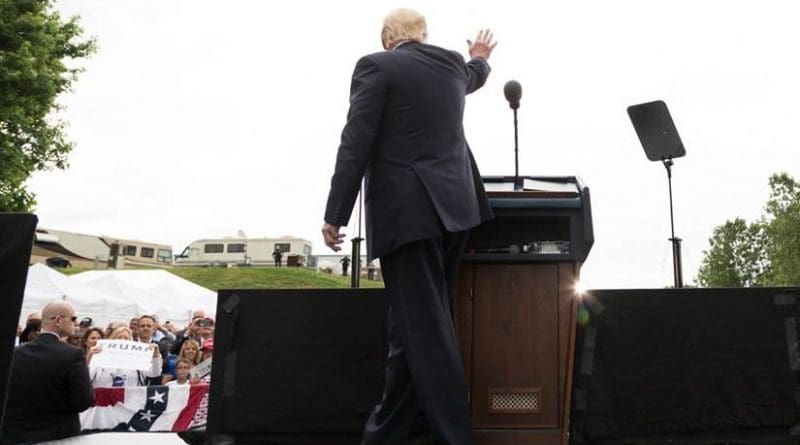Surviving The Trump Problem – Analysis
By Observer Research Foundation
The common strategic interest between the US and India will last a lot longer than the Trump administration, and New Delhi needs to take a longer-term view.
By Rajesh Rajagopalan
The consensus among Indian foreign policy analysts appear to be that Prime Minister Modi cannot achieve much in his forthcoming visit to Washington. President Donald Trump is without question the most difficult American leader that any Indian leader has had to deal with, his unpredictability making it hard to even consider how India should proceed with the pressing strategic challenges it faces or what role New Delhi can be confident the US will play in meeting such challenges. And this comes at a particularly unfortunate time, just as China’s leadership seems to be getting comfortable using its immense and still growing power to push its neighbours around and assert its dominance over the region. Trump’s zig-zagging approach to China, from fierce criticism and threats to seeking China’s help to deal with North Korea, highlights the problem that India faces.
But the Trump problem should not blind us to one central reality: the disparity in power between India and China is not only vast but still growing, and it will continue to grow over the medium term. Thus, the challenge that China represents is not just a short-term one but also a medium-term one, and even possibly a long-term one. On the other hand, the Trump problem, serious as it is, is a relatively short-term one. In dealing with Trump, New Delhi must recognise that as yet, Trump is an aberration and he does not represent the strategic consensus in Washington that sees a much larger role for the US in the Indo Pacific. Indeed, going by the views expressed by even his senior officials such as Secretary of Defense James Mattis and Secretary of State Rex Tillerson,
Trump may not even be representative of the consensus within his own administration
This suggests some outlines for India’s strategy in the next few years in dealing with the US.
The first part of it is to wait out the Trump administration. Even if President Trump refuses to recognise it, the US does have an interest in ensuring that the Indo Pacific region is not completely under Beijing’s thumb. This is an objective that Washington shares with many countries in the region who are not keen to live under China’s regional hegemony either, which makes the US a natural partner for these countries. This common strategic interest would eventually return, if not in the Trump administration itself, then in the next one. The common strategic interest between the US and India will last a lot longer than the Trump administration, and New Delhi needs to take a longer-term view.
The second part of India’s strategy should be to focus more on Washington’s permanent establishment than the White House. The clear commitment from President Trump’s senior officials to the region should be integrated into India’s strategy. For almost two decades, New Delhi has depended on the White House to push US-India ties against American foreign policy and security bureaucracies that appeared less driven by the strategic vision at the top.
The bureaucracies are also likely to provide greater steadiness and continuity to US policy than the White House. In a strange twist of strategic fate, India will now have to depend on the US bureaucracy to steady the relationship and hopefully, even carry it forward to a limited degree. This is harder, but for now at least, both the Indian political leadership and the defence and foreign policy establishments need to build deeper relationships with the US permanent establishment than depend on the unsteady Trump White House.
But India must also double-down on other aspects of its strategy. For one, it must pay greater attention to building up its own military and diplomatic capacities. There has to be greater resolve in both building up India’s border infrastructure and Indian military strength. This would have been unavoidable in any case, but the uncertainties about the Trump administration will hopefully inject a greater urgency into India’s efforts. At the same time, there needs to be more determined political direction to this effort, instead of leaving military power development and plans just to the military.
On the other hand, while building up its own capability is an important aspect, New Delhi must also recognise that this by itself simply will not suffice. It needs to be supplemented with other regional partnerships. It is the clear recognition of this strategic reality that is behind India’s dramatic improvement in ties with regional partners such as Japan and Australia. These were countries with which India had (at best) correct but cool ties for decades, but now need each other’s support. India should not let unnecessary old baggage come in the way of building these ties. It again falls to the political leadership to direct these relations, instead of letting it be dictated by bureaucratic whims and fancies.
Ultimately, the US partnership has to be an essential component of India’s strategy, because neither indigenous effort nor regional partnerships will suffice in dealing with the China challenge. Obviously, this is possible only if Washington is willing and able. What is at question is the willingness, not the ability (at least not yet). But strategic logic suggests that this is bound to change. India and the rest of Asia may have little choice but to wait out and survive the Trump problem.

